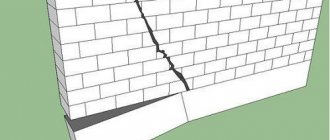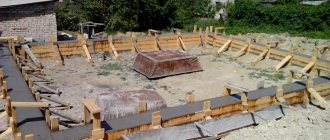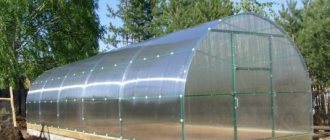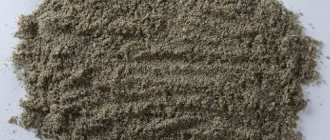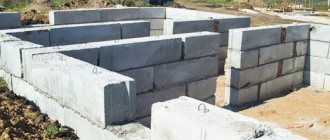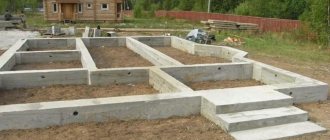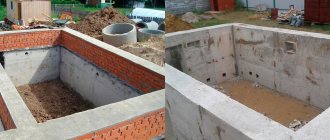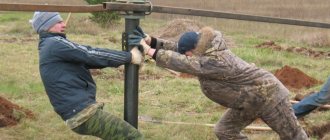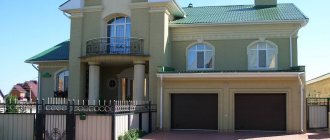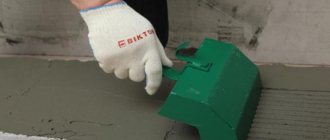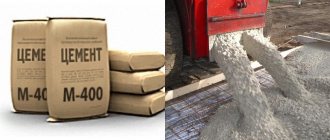Laying a waterproofing layer between the foundation and the walls (brickwork) will reliably protect the latter from the harmful effects of moisture. This is one of the basic requirements for the construction of buildings and structures. The number of waterproofing materials currently offered is massive. But among them there is an old-timer who is still in demand. This is roofing felt - ordinary cardboard, which is impregnated with petroleum bitumen, and then covered with a layer of refractory bitumen on top.
Waterproofing the foundation with roofing felt is characterized by a simple process and low cost. Gluing roofing felt to the foundation is actually very simple, especially since manufacturers today offer self-adhesive types. By the way, about the types of this waterproofing material. You can find a wide variety of them on the market. Here you can find conventional roofing models and lining ones, self-adhesive and reinforced with increased strength, built-up and polymer-bitumen. Each of them has its own technical and operational characteristics, on which the price of the product depends.
And here the consumer may have a question about what kind of roofing material can be used for waterproofing the foundation, because only a specialist can understand such a variety. In principle, there is nothing complicated here. Any of the above types can be laid on the foundation of the building. After all, it's all about the price. But most often they use the lining option, designated as “RP” with additional letter and numeric meanings. By the way, “RP” is lining roofing material, “RK” is roofing material. They differ from each other in the density of the product. For the first it is 300 g/m², for the second it is 350 g/m².
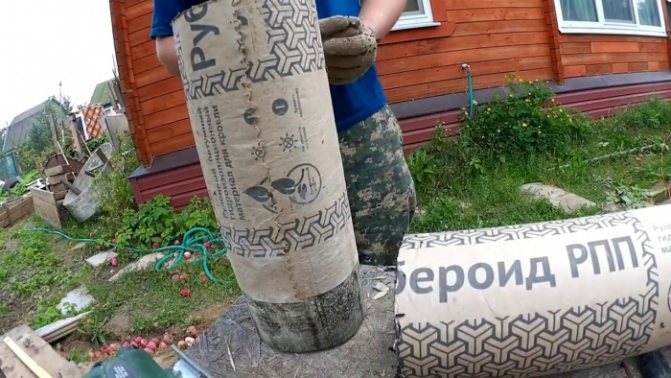
How to lay roofing felt on a flat and pitched roof
Ruberoid is considered one of the most popular rolled materials for organizing roofing, which has a significant service life. Roofing felt can be laid on a roof of any shape and type; it is even suitable for installation on top of old roofs. In this article we will talk about what kind of roofing material is placed on the roof, as well as how to do it correctly.
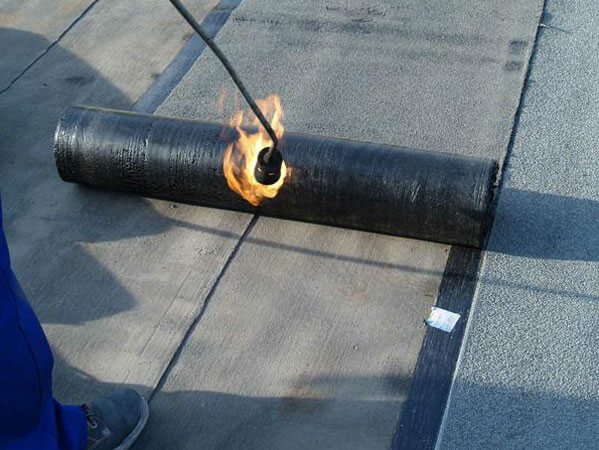
We select high-quality roofing felt and prepare for its installation
Roofing felt is made from roofing cardboard impregnated with petroleum bitumen with a low melting point. After this, it is covered on both sides with an even layer of refractory bitumen. As a protective layer, powder with talc, asbestos or other mineral materials is used. Even before laying roofing felt, you need to make sure that the material is of high quality.
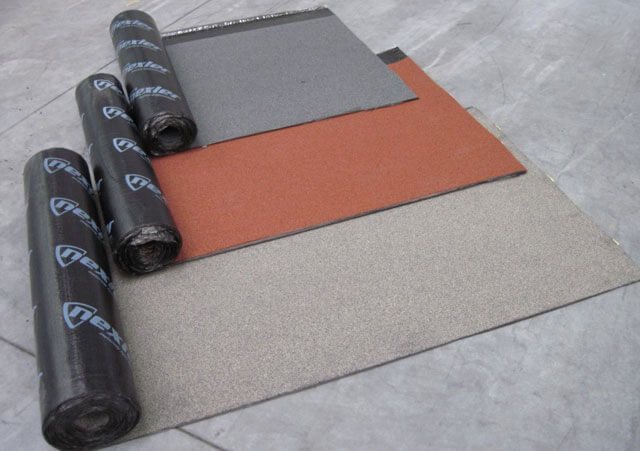
To control quality, rolls must be rolled out and carefully inspected for the following defects:
There should be no light spots in the cut areas. If they are present, this indicates that the cardboard inside was not completely saturated with bitumen during the manufacture of the material. Insufficient impregnation of cardboard significantly worsens the quality and service life of the material. A roof covered with such roofing material will not last very long.
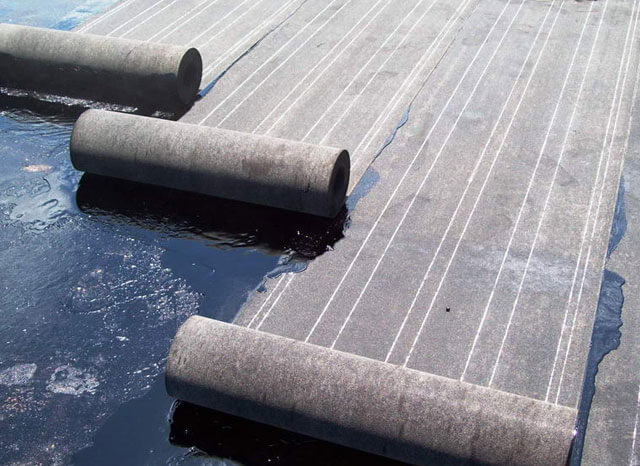
According to the technology, before covering the roof with rolled bitumen material, it should be prepared for installation. To do this, at least a day before the start of roofing work, roll out the rolls and give them time to straighten out to get rid of waviness. This significantly simplifies the process of laying roofing felt on the roof and improves the resulting quality of the coating. If the weather is warm, you can roll out roofing material outside, but if it is cold or damp, then this should be done exclusively indoors.
Technical characteristics of RKP roofing felt
| Index | Meaning |
| Protective coating top/bottom | talc/film |
| The basis | cardboard |
| Flexibility temperature | 5 degrees C |
| Heat resistance | 80 degrees C |
| Breaking load | 28 kgf |
| Roll sizes | 1x15 m |
| Roll weight | 19 kg |
| Manufacturer | Ryazan KRZ |
Roof design features
In order for the roof to ultimately last as long as possible, the installation of roofing felt must be carried out on a roof with a correctly designed attic.
The attic must contain:
- proper ventilation;
- vapor barrier layer;
- drainage system manufactured in accordance with standards.
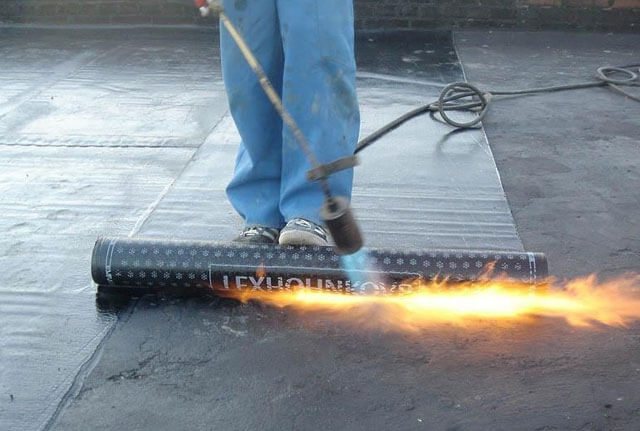
Improperly organized drainage from the roof can cause water stagnation during rainfall, as well as during the thaw period.
For greater reliability, roofing felt is laid in several layers, and the amount of material required will be determined by the structural features of the roof.
Roofing felt can be used to cover flat roofs, including those in use. In this case, the roofing carpet must be made of at least five layers of material. It is especially necessary to monitor those places where the roof comes into contact with structures, including pipes and walls. In such places it is necessary to lay additional layers of material, thereby increasing the strength of the coating.
Pitched roofs require a special approach. Before laying roofing felt on a roof with slopes, you must first check their angle of inclination, since the optimal thickness of the roofing covering will depend on this - as a rule, this is 2-5 layers. If the roof has a slope of 15 degrees, then at least three layers of roofing material will need to be laid. And if it exceeds 15 degrees, then at least two layers of roofing material will be required. Roofing felt is also used to protect the contact area of roofing planes with complex shapes.
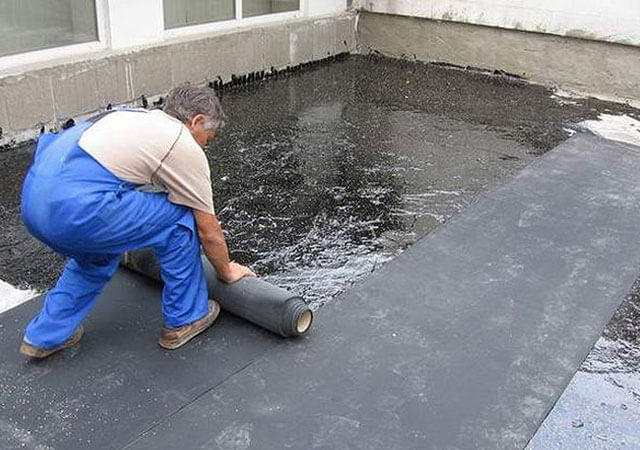
You can lay roofing felt using one of the following technologies:
- mechanical fastening;
- gluing to bitumen mastic.
Roofing felt must be laid on a properly prepared base.
Brands and characteristics ↑
GOST 10923-93, in accordance with which roofing felt is produced, divides products into several grades, differing in the type of base (cardboard) and the nature of the topping.
In addition to those specified in GOST, you can find other brands of roofing felt on sale, manufactured according to the manufacturer’s specifications. Let's decipher the main designations found in product names:
- The first letter is always “P” - roofing material.
- The second symbol is the type of material: “K” - roofing; "P" - lining.
- The third letter is the type of topping: “P” - dusty (talc); “K” - coarse-grained; "M" - fine grain; “C” is a scaly coating (usually mica; “C” is color-resistant. The letter “E” means that the roofing material not only has a coating, but has increased elasticity and frost resistance.
The numbers following the letter designation indicate the brand of roofing cardboard. The higher the number, the denser the cardboard, the greater the thickness of the roofing material and, accordingly, the stronger the material.
The width of roofing felt is 1000 mm, but some factories produce rolls with a width of 1025 and 1050 mm. Tolerance - 5 mm. It is possible to produce rolls of non-standard width. The length of rolls of the RKK brand is 10 m, RKCh and RKP - 15 m, RPP - 20 m. The thickness is not standardized, the weight in GOST is given for reference.
Laying roofing felt in several layers
A lining type of roofing material with fine powder should be used as the lower layers of the coating. In this way, it is possible to achieve the tightest possible fit of the layers to each other, as well as increase the reliability of the roof and resistance to external factors.
When laying the outer layers, according to the technology, the material should overlap each other by approximately 8-10 cm. Most often, manufacturers make roofing material with a powder of large fractions, while leaving an unsprinkled strip on one side to allow faster laying of the material and ensuring reliable gluing of strips to each other.
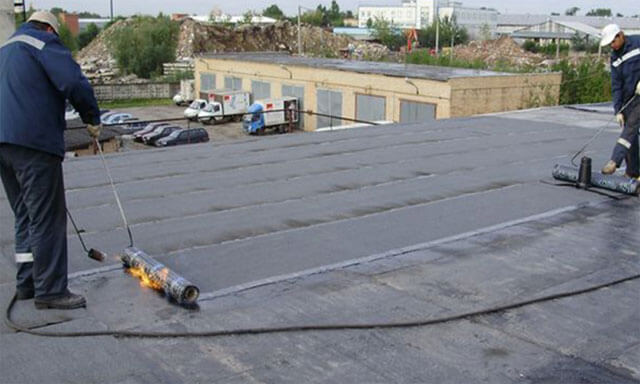
To figure out which side to lay roofing felt on the roof, you need to know that if it has powder on one side, then it should always face up.
It doesn’t matter what type of roofing and how many layers will be used, only the last, top layer of roofing material should have a powder with large particles.
If it turns out that coarse-grained roofing material must be laid over the entire surface of the roof, then a thicker layer of adhesive composition should be applied to join the strips. Before gluing roofing felt, to improve the quality of the roofing covering, it is advisable to carefully remove the powder at the joints without damaging the layer of bitumen on the roofing felt.
Dimensions and thickness
Roofing material can have various parameters determined by standards and GOST. They will depend on its brand.
Table. Main characteristics of roofing felt.
| Index | Value thresholds |
| Width | 1 000, 1025, 1050 mm |
| Roll weight | About 22-25 kg |
| Square | 10, 15, 20 sq. m. |
| Weight 1 sq.m. | About 2 kg |
| Content of bituminous substances | No more than 0.8 kg/sq.m. |
| The ratio of the mass of impregnated bitumen to the cardboard base | 1,25-1,4 : 1 |
| Tensile strength | About 216-333 N |
| Density | 0.35-0.4 kg/sq.m. for roofing and 0.3 kg/sq.m. – for lining type |
The material, when bent around a 20-30 mm rod, should not crack at a temperature of no more than 18-25 degrees. Some deviations in size are acceptable: for example, in area they can be no more than 0.5 m2, and in the width of the roll - no more than 5 mm.
On a note! For the construction of the roof, roofing material with a thickness of at least 4-5 mm can be used. A coating up to 3.5 mm thick is applicable as a lining for roofing material.
How to lay roofing felt on a concrete roof
Before laying roofing felt, the concrete base must be carefully prepared:
- you will need to get rid of garbage;
- the base must be leveled: all joints, potholes and cracks must be sealed;
- This is followed by a thorough wiretapping;
- at the last stage, a continuous layer of primer is applied based on bitumen (4 l), kerosene (6 l) and finely ground chalk (1.5 kg).
A primer is necessary to bind particles of dust and debris and give the base better adhesive properties.
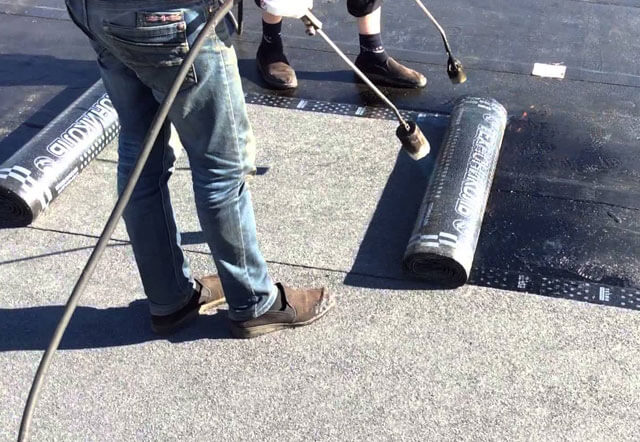
The material is attached using the gluing method. The mastic is applied along the entire strip. Straighten the sheets of roofing material, starting from the center and ending with the edges, preventing air bubbles from forming. To get rid of the bubble that has arisen, it is pierced, after which this place is firmly pressed to the base.
Before laying the next sheet, you should definitely pause for 12 hours, during which the glue dries completely. After this, they get rid of possible flaws and move on to further installation.
To simplify the installation process, it is better to purchase material with one self-adhesive side. In this case, the answer to which side to put the roofing felt on the roof will, of course, be the side with the applied layer of glue. Before laying this type of material, which is carried out in the same way as conventional roofing felt, you need to get rid of the protective film on the self-adhesive side. Try not to hesitate when laying the material, otherwise the adhesive may simply dry out. After this, the glued web should be rolled with a roller.
Technical characteristics of RKK roofing felt
| Index | Meaning |
| Protective coating top/bottom | crumb/film |
| The basis | cardboard |
| Flexibility temperature | 5 degrees C |
| Heat resistance | 80 degrees C |
| Breaking load | 32 kgf |
| Roll sizes | 1x10 m |
| Roll weight | 27 kg |
| Manufacturer | Ryazan KRZ |
We arrange a pitched roof
A pitched roof is characterized by the installation of continuous sheathing, which is necessary to give the surface of the structure evenness and rigidity. Properly constructed sheathing will prevent the formation of uneven spots on the roofing material, which often cause very rapid wear and tear or damage from gusty winds.
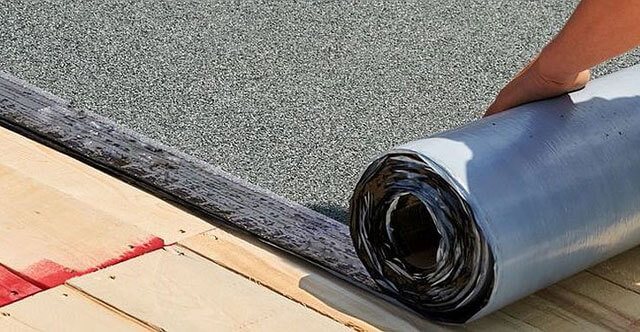
To create the sheathing we will need:
- edged or unedged board;
- OSB or DSP board;
- plywood.
To give the roof slope a more reliable covering, there are three methods of laying it for the master to choose from:
- placing roofing felt sheets horizontally;
- along the slope line;
- composite method, when the next layer is laid at right angles to the previous one.
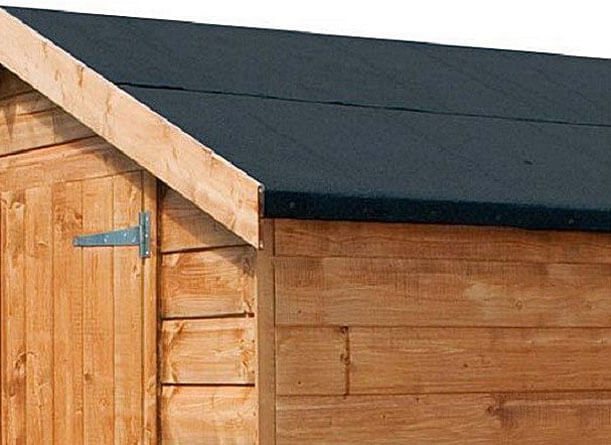
Any of these methods provides high-quality protection against water ingress.
The use of roofing felt during repair work - which side to lay
You can also lay roofing felt on the roof on top of old material if the roof is made of shingles or the same material. Initially, the old coating should be thoroughly cleaned, especially the seams between the panels.
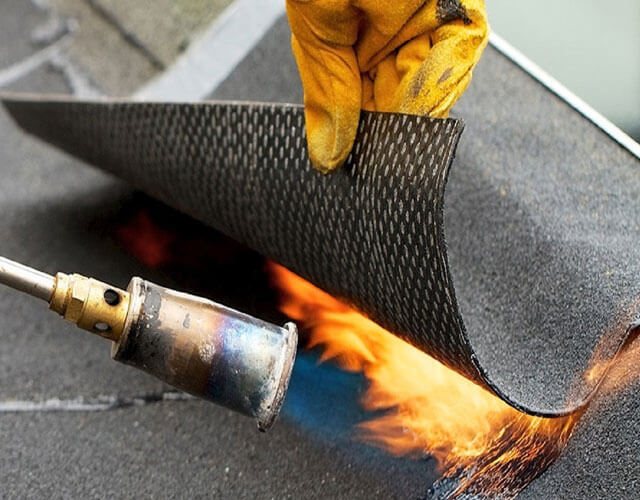
Next you will need to complete the following steps:
- thoroughly clean problem areas;
- remove all unnecessary torn fragments until only whole places remain;
- make cross-shaped cuts in the air and water bubbles;
- the cut areas need to be thoroughly treated with mastic;
- get rid of old fasteners, as they can damage the new roofing material;
- At the last stage, the old roof should be thoroughly dried.
So we figured out how to properly lay roofing felt on a wooden roof. In addition, it is worth noting that aluminum tape, as well as nails of a certain length, can be used as fasteners.
Features of choosing the type of foundation
The support must be strong enough to withstand significant loads. The type of soil on which the structure is built is of great importance. First, you need to collect the most complete information about the soil and the level of groundwater. It is important to know the level of peak groundwater rise and soil composition. Exploration drilling will provide the most complete data, but it is a labor-intensive undertaking.
The easiest way to collect information is to interview future neighbors or contact land management authorities. The information received will help you choose the right:
- Structural type of support structure
- Define its parameters
- Select the necessary materials
- Choose a time to carry out work.
In any case, effective waterproofing will be a mandatory stage in the construction of a building. But depending on the type of support system, the method of its implementation will be slightly different.
Which roofing felt to choose for the foundation
The insulation material is a base impregnated with bitumen. Initially it was only cardboard, later panels with fiberglass and non-woven fabric appeared. Some types of insulation have received their own names:
- Rubemast. Made from cardboard, designed to insulate the foundation.
- Synthetic-based euroroofing felt is laid in a roofing pie.
- Glass roofing material is made from fiberglass and is used as a roofing covering.
Another layer of bitumen is laid on the impregnated base, and topping is placed on top of it. It can be large, scaly or small. Such varieties are used for roofing and are marked with RK. For insulation, the so-called cushioning fabric with dust-like coating is often chosen. RPP marking.
The density of the fabric also differs. For roofing, the indicator varies from 250 to 350 g/sq.m. m, for cushioning from 200 to 300 g/sq. m. For waterproofing, theoretically, you can choose any type, which will determine the density of the canvas. However, if you decide to lay the roof covering, you will have to remove the coating from it, otherwise it will not be possible to properly glue the next layer.
When choosing, it is worth considering the installation method. Traditionally, the material is glued in several layers onto bitumen mastic, cold or hot.
To facilitate installation, self-adhesive varieties are used. Bitumen paste is already applied on their reverse side. It needs to be heated and the strip pressed tightly to the base. This type of insulation is also called built-up insulation; its price is slightly higher than the standard one.
Technical characteristics of Roofing felt RKK GOST
| Index | Meaning |
| Protective coating top/bottom | crumb/film |
| The basis | cardboard |
| Flexibility temperature | 5 degrees C |
| Heat resistance | 80 degrees C |
| Breaking load | 32 kgf |
| Roll sizes | 1x10 m |
| Roll weight | 35 kg |
| Manufacturer | Ryazan KRZ |
How to lay roofing felt on a foundation: description of technology
The insulating carpet “envelops” the entire supporting structure. To equip it, two types of protection are installed.
By type of protection
Horizontal
The first layer of roofing felt is laid under the supports, directly on the backfill pad in several layers. The strips are laid with a slight overlap so that there are no gaps left. The length of each of them should be such that after pouring it is possible to bend the edges of the insulation upward and secure it to the concrete wall. For the same reason, the width of the resulting layer should also be greater than that of the main structure.
The second layer is mounted in a similar way, but on top of the supports. Beginners in construction do not always understand why roofing felt is needed between the foundation and the walls. It is believed that one horizontal layer is enough. This is a serious mistake, since each of the waterproofing layers prevents capillary absorption of moisture, which means destruction of the supporting system. It is possible to lay the covering under the walls only at the construction stage, so it will be impossible to correct the mistake.
Vertical
In order to obtain a continuous sealed “cocoon” that completely covers the foundation, its walls are also insulated. Work is carried out in a vertical plane.
The canvas is glued to the base with mastic and pressed against it with force. The strips are laid with an overlap of 10-15 cm, otherwise cracks may appear after the adhesive mixture dries.
By foundation type
Strip foundation
In this case, the waterproofing covers the supports, basement or basement. It is important to ensure good ventilation so that the mastic dries well. High humidity makes this impossible. Operations are carried out in the following sequence:
- We clean the base from debris, dirt and dust. We carefully inspect and note any defects found. They need to be sealed with repair mortar, otherwise the waterproofing sheet may tear in these areas. We repair the flaws and wait for the mixture to dry completely.
- We prime the base. We choose a suitable primer, possibly one with water-repellent properties.
- After the primer has dried, carefully coat the surface with bitumen mastic. Apply it in two or three layers. Don't forget that each of them must dry before applying the next one.
- Strips of insulating fabric cut to the required size are heated with a burner, applied to the surface with an overlap of 10-15 cm. We additionally coat the edges with mastic and press well.
After installation, we once again warm up the entire insulating carpet of the strip structure to ensure that it has the best possible adhesion to the base. The heated bitumen paste will stick securely to the wall.
Slab system
It is a slab “recessed” into the ground, so the waterproofing technology is almost no different from horizontal. However, there are still some features. If the work is not carried out during the construction phase, the structure must be vacated. To do this, trenches are dug along the entire perimeter, the width of which is at least a meter. The depth should be about half a meter greater than the depth of the slab.
Next, the foundation structure is cleaned. All detected defects are repaired with a repair mixture. Then two layers of bitumen paste are laid alternately. They are allowed to dry thoroughly. Only after this is the roofing felt installed. First, it is cut so that the stripes are enough for the horizontal plane and both vertical ones.
Brands of roofing felt
According to GOST, roofing felt has all kinds of grades. Knowledge of their features and properties will help you make the right choice of coating for a particular purpose.
GOST 10923-93. Ruberoid. Technical conditions. Downloadable file (click the link to open the PDF in a new window).
RKP 350 is considered a roofing product and has a dust-like layer of coating on both sides. It is based on cardboard, which has a density of at least 350 g/m2. It is used for the construction of roofs of various types (recommended for creating reinforced concrete roofs in the first place), suitable for laying under soft materials, and can act as a roofing covering itself. Inexpensive and has excellent waterproofing properties.
RPP 300 is considered a lining, usually used in the construction of foundations, for covering roofs with small slope angles, various engineering structures, and is used for sealing ventilation, as a lining layer.
RKK 350 is a material for flat roofs that has a coarse-grained coating, which gives it additional strength. This type of roofing material is usually used in regions where weather conditions are unfavorable - there is often hail, strong winds, and it often rains.
Table. Technical characteristics of the main brands of roofing felt.
| Brand | RKP 350 | RPP 300 | RKK 350 |
| Water absorption over 24 hours, % | No more than 2 | No more than 1.8 | 2 |
| Heat resistance, C° | 80 | 80 | 80 |
| Water resistance, h | 72 | 72 | 72 |
| Width, m | 14 | 1 | 1 |
| Length, m | 15 | 15 | 10 |
| Breaking force, N | 274 | 216 | 312 |
| Weight, kg | 24-27 | 20 | 25 |
| Weight of powder and bitumen layers, g/m2. | Not less than 800 | Not less than 500 | Not less than 800 |
How to lay roofing felt on a foundation with your own hands
Laying a waterproofing layer between the foundation and the walls (brickwork) will reliably protect the latter from the harmful effects of moisture. This is one of the basic requirements for the construction of buildings and structures. The number of waterproofing materials currently offered is massive. But among them there is an old-timer who is still in demand. This is roofing felt - ordinary cardboard, which is impregnated with petroleum bitumen, and then covered with a layer of refractory bitumen on top.
Waterproofing the foundation with roofing felt is characterized by a simple process and low cost. Gluing roofing felt to the foundation is actually very simple, especially since manufacturers today offer self-adhesive types. By the way, about the types of this waterproofing material. You can find a wide variety of them on the market. Here you can find conventional roofing models and lining ones, self-adhesive and reinforced with increased strength, built-up and polymer-bitumen. Each of them has its own technical and operational characteristics, on which the price of the product depends.
And here the consumer may have a question about what kind of roofing material can be used for waterproofing the foundation, because only a specialist can understand such a variety. In principle, there is nothing complicated here. Any of the above types can be laid on the foundation of the building. After all, it's all about the price. But most often they use the lining option, designated as “RP” with additional letter and numeric meanings. By the way, “RP” is lining roofing material, “RK” is roofing material. They differ from each other in the density of the product. For the first it is 300 g/m², for the second it is 350 g/m².
Technical characteristics of RPP roofing felt
| Index | Meaning |
| Protective coating top/bottom | talc/film |
| The basis | cardboard |
| Flexibility temperature | 5 degrees C |
| Heat resistance | 80 degrees C |
| Breaking load | 22 kgf |
| Roll sizes | 1x15 m |
| Roll weight | 16 kg |
| Manufacturer | Ryazan KRZ |
Types of foundation waterproofing with roofing felt
Foundation waterproofing with roofing felt is divided into two groups:
As for horizontal insulation, it is laid under the foundation and on the horizontal plane of the structure itself. Laying roofing felt under the foundation protects the structure itself from the negative effects of moisture that moves up through the capillaries of the soil. To do this, a roofing felt strip is laid in several layers on the cushion, which is poured under the foundation of the house, so that after pouring the concrete solution and drying the concrete, its edges can be folded and attached to the walls of the foundation. Therefore, the width of the laid strip should be 20-25 cm greater than the width of the poured base.
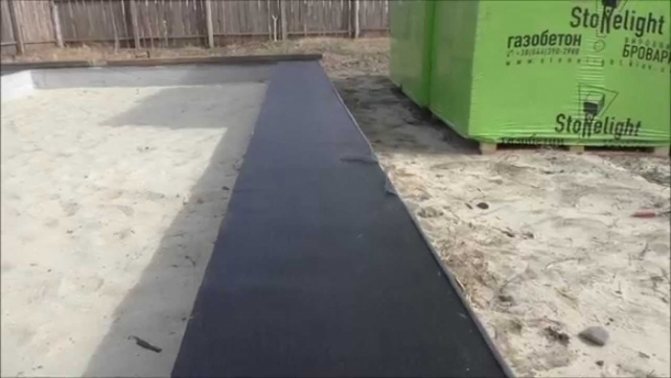
Vertical waterproofing protects the foundation structure from the sides. To do this, roofing felt is attached to the foundation using the gluing process. What is bitumen mastic used for? First, the walls of the structure are treated with a primer, after which mastic is applied. And the waterproofing material itself is glued to it. Since the width of the material is not enough to cover the entire length of the structure, the strips are laid overlapping with an offset of 10 cm. In this way, roofing felt can be laid in several layers, and each layer can be coated with mastic.
Types of material
There are several options for classifying roofing felt. It may differ in some technical characteristics, type of topping, laying method or density. So, based on the type of topping, several categories of roofing material can be distinguished.
- With coarse bedding . The material is considered universal and is used for various purposes, including waterproofing roofs. Coarse powder may only be present on the front side of the material.
- With dust-type coating . To create it, chalk or talc is used, which is applied to both sides. This type is used only to create the lower layers of the roof.
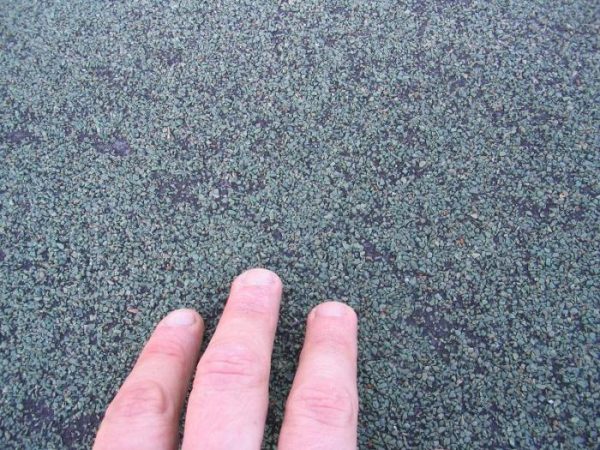
Also, all types of coating described can be divided into the following categories.
- Glassine is an ordinary roofing material based on cardboard impregnated with bitumen. The material is laid in at least 3-4 layers - this thickness will allow it to be used for at least ten years.
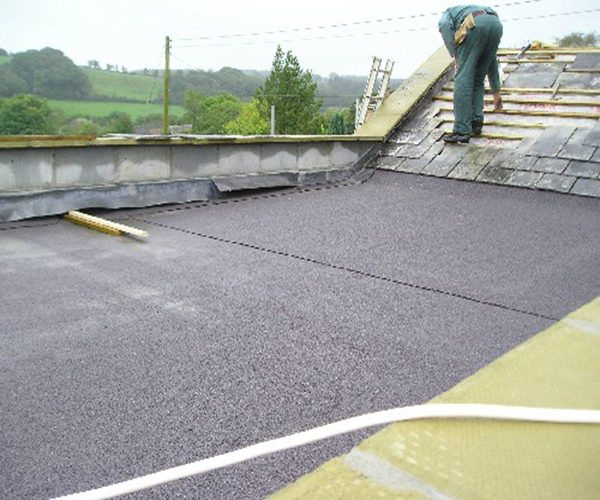
Where is roofing felt used?
On a note! There is also liquid roofing felt on sale, which resembles mastic in appearance. It includes various polymer additives. The material is not heated before use and is usually used for roof repairs.
Waterproofing technology
Until recently, the technology of laying roofing felt on the foundation did not shine with complex operations. Most often it was placed on the upper horizontal surface, and that was all. The side planes were usually treated with hot bitumen. All this was unreliable and worked for no more than 10 years.
Modern technologies require a different approach. Here is the sequence of waterproofing operations carried out.
- All foundation planes are cleaned of dust, checked for defects, which must be covered with a repair mortar (can be cement-sand).
- Next, when everything is dry, primer is applied.
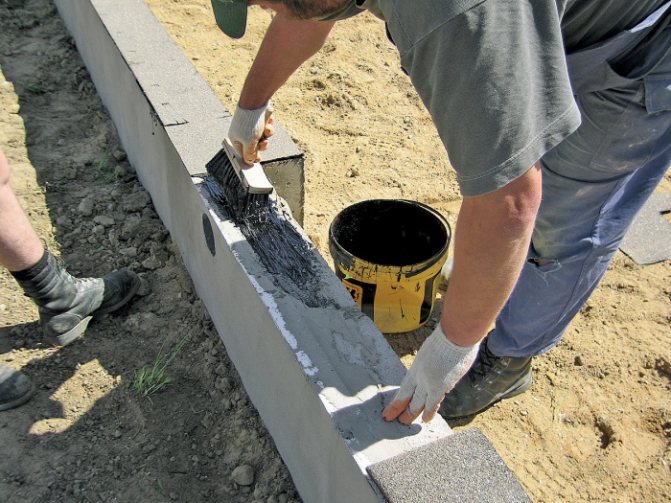
- After this layer has dried, bitumen mastic is applied to the foundation plane. It is better to use two or three layers, each of which must dry well before applying the next.
- Before laying the material itself, the strips cut to size must be heated with a gas burner.
- They are installed with an overlap of 10 cm between the strips. Don’t forget to coat the edges of the roofing material with mastic for better bonding and sealing of the waterproofing layer.
- And again the entire laid material is heated.
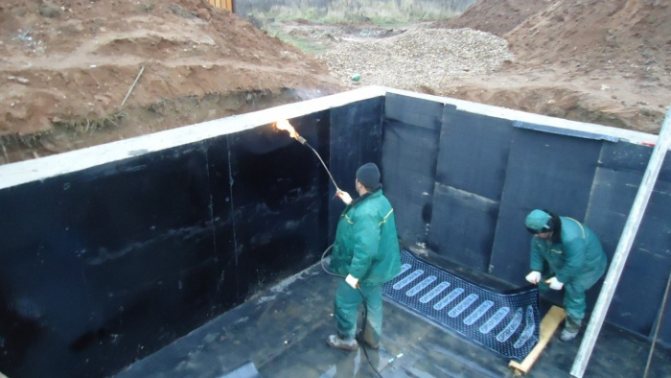
This technology is used for waterproofing strip foundations when their base or basement is covered with roofing felt. At the same time, in order for the adhesive to hold the waterproofing strips together well, care must be taken to ventilate the basement floor. High humidity is the enemy of mastic.
By the way, when pouring the foundation, formwork is used. So, if this structure is assembled from wooden lumber, then between the elements (boards) there are cracks and gaps through which the concrete solution flows, thereby increasing its consumption. Therefore, formwork with roofing felt glued to its inner surface solves this problem.
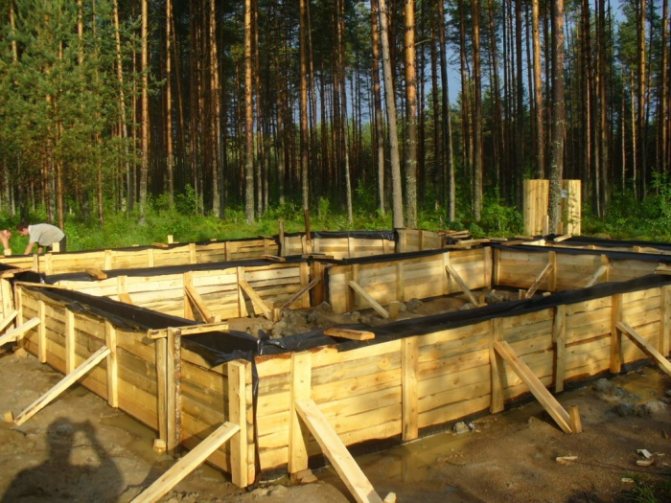
Waterproofing a columnar foundation
Roofing felt is also used to construct a columnar foundation. But there is one difficult point here. What are foundation pillars? These are deep wells filled with concrete. It is clear that the part that is located above the ground is easy to waterproof. The technology is the same as described above. What to do with the part that is located in the ground.
After all, in this case formwork is not used to secure the material itself to it. Because the walls of the well will perform restrictive and formative functions. Therefore, there is only one way out - to make something from roofing felt in the form of formwork, shaped like a cylinder, that is, the shape of a well.
Installation instructions
Let us consider in detail how the process of covering the roof of a small wooden shed with this type of material occurs.
Step 1. Measurements are taken from the roof and the required amount of coating is calculated. In this case, future overlaps of the material must be taken into account.
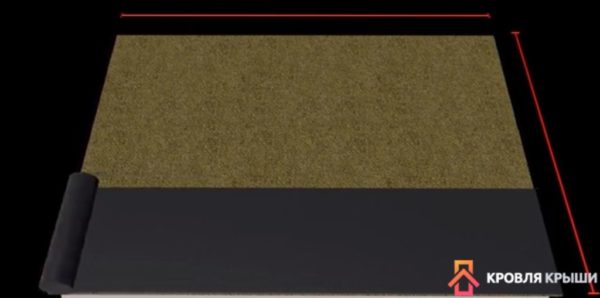
The required amount of material is determined
Step 2. The roof surface is cleared of debris, nails, and carefully leveled. It is important to remove all elements that could damage the material in one way or another.
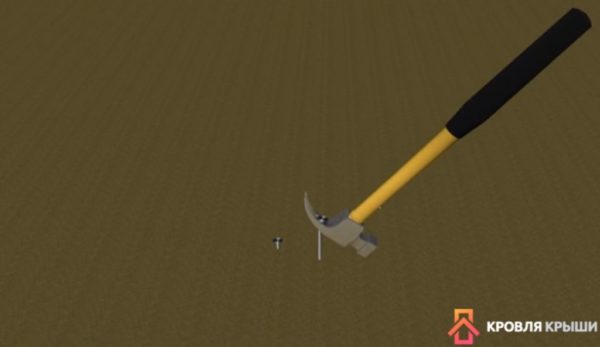
Old nails are removed
Step 3. If necessary, wet cleaning of the roof and further drying of the base can be used. If it is not dried, then rotting processes may begin under the roofing felt.
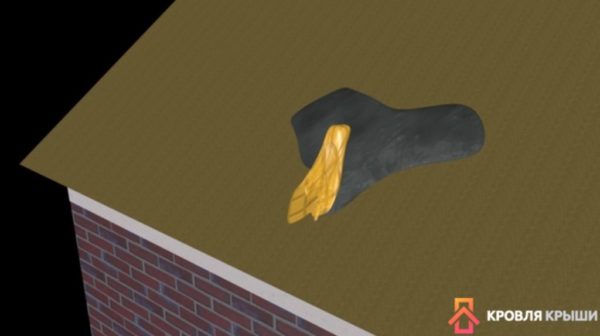
Wet cleaning of the base
Step 4: The roof deck is carefully inspected for damage or rot. All damaged areas must be replaced with new ones and repaired.
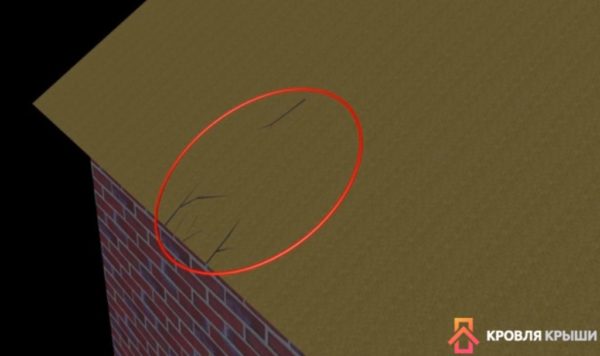
Inspecting the surface for damage
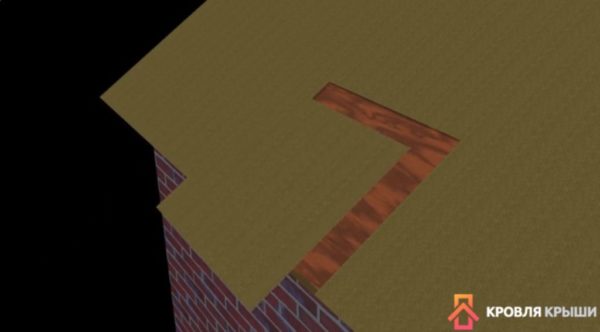
Replacing the damaged area
Step 5. Installation begins from the bottom of the roof. The roll is spread along the eaves, but for ridge roofs, installation can begin from the ridge - in this case, in the upper part the covering should hang down by about 30 cm.
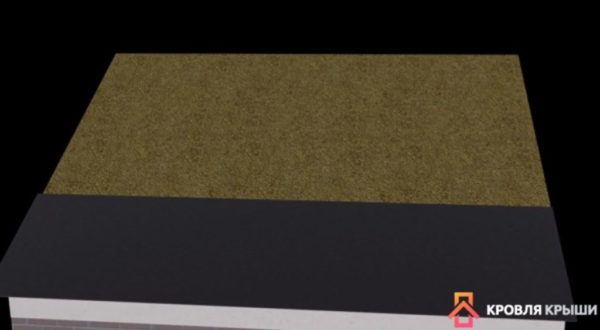
Installation starts from the bottom of the roof
Step 6. The edge of the roofing felt is aligned so that it hangs about 2 cm from the edge of the roof - this will allow water to drain to the ground.
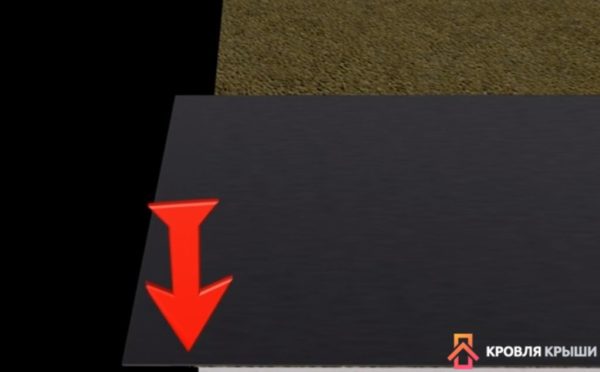
The edge of the material should hang down about 2 cm
Step 7. The material is fastened using galvanized fasteners from the edge of the roof from where the roll was rolled out.
Step 8. The material is pulled towards the other edge of the roof, opposite the relatively fixed section of the material. The effort applied is moderate - the roofing felt is easy to tear.
Step 9. The roofing felt is nailed to the base with nails with wide heads in increments of 30 cm around the perimeter of the roof and 60 cm in the upper part of the section of roofing felt, which will be covered by the overlap of the next section. It is important not to damage the integrity of the material with the caps.
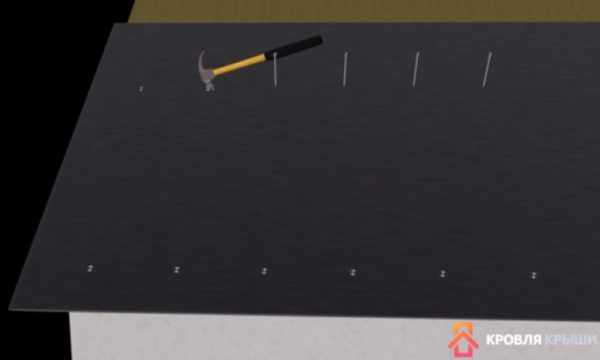
The material is nailed
Step 10. The next strip of roofing material is rolled out in the opposite direction relative to the previously laid one. It is laid with an overlap of 20 cm on the previous one.
Step 11. The roof ridge is covered with two pieces of roofing material so that both strips extend onto the roof ridge itself.
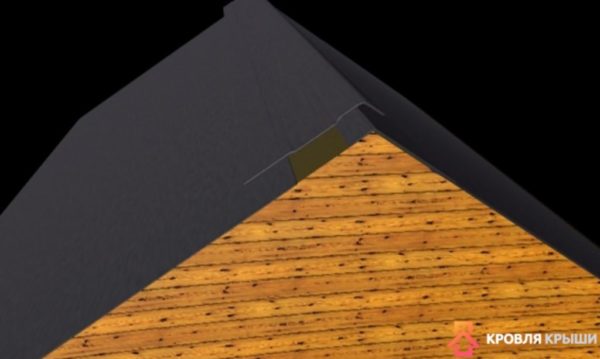
Laying the second section overlapping the ridge
Step 12. Nail heads are treated with mastic or resin so that they are further protected from moisture.
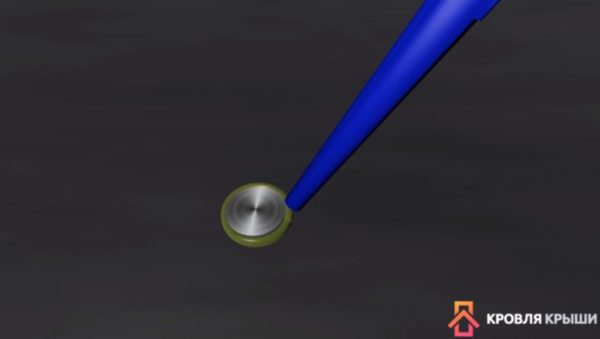
Nail heads are treated with mastic

